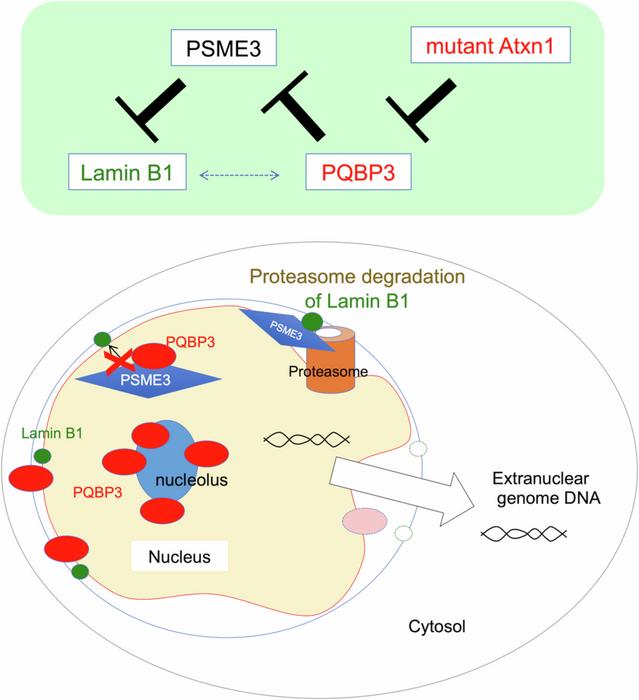Tokyo Medical and Dental University (TMDU) researchers elucidate the role of PQBP3 in stabilizing the nuclear membrane and its relationship to senescence and neurodegeneration

Credit: Department of Neuropathology, TMDU
Tokyo Medical and Dental University (TMDU) researchers elucidate the role of PQBP3 in stabilizing the nuclear membrane and its relationship to senescence and neurodegeneration
Tokyo, Japan – Aging is the prime cause of neurodegenerative diseases, such as Alzheimer’s disease, Parkinson’s disease, and amyotrophic lateral sclerosis. But what exactly increases the prevalence of these brain disorders as one grows older? The molecular forces linking aging, cellular senescence, and the onset of these neurodegenerative conditions are not well understood.
In a recent study published online on August 5 2024 in The EMBO Journal, researchers from Tokyo Medical and Dental University (TMDU) in Japan have uncovered a crucial piece of this puzzle by focusing on the role of a single nucleolar protein.
A research team led by Professor Hitoshi Okazawa revisited polyglutamine binding protein 3 (PQBP3), a protein they had discovered themselves over 20 years ago. Through a comprehensive screening of normal proteins that bind to disease-causing proteins in polyglutamine diseases such as Huntington’s, they identified several proteins in the PQBP family. After exploring the functions and pathological relevance of PQBP1 and PQBP5, Prof. Okazawa and colleagues turned their attention to PQBP3.
To shed light on the role of this protein, the researchers employed cellular senescence as a model to study aging. Senescence refers to a state in which a cell no longer undergoes division, but remains alive and metabolically active. This state, which can be replicated in cell cultures, occurs naturally in our bodies and is typically observed in aging cells.
Through super-resolution fluorescence microscopic observations, the researchers observed something peculiar about the location of PQBP3. “PQBP3 typically localizes around the periphery of the nucleolus within the nucleus, but during senescence, PQBP3 relocated from the nucleolus to the nucleoplasm or cytoplasm,” says Prof. Okazawa. He adds, “This relocation of PQBP3 was accompanied by leakage of nuclear DNA into the cytoplasm. Most importantly, we then observed via electron microscopy that the nuclear membrane structure was destabilized in cells where PQBP3 had moved to the cytoplasm.”
To shed light on this destabilization of the nuclear membrane, the researchers conducted a bioinformatics analysis using protein interaction databases. The results suggested that PQBP3 binds to a protein called proteasome activator complex subunit 3 or PSME3, which plays a key role in the degradation of other proteins. Upon further investigation, the team found that, under normal circumstances, a portion of PQBP3 moves from the nucleolus to the nuclear membrane and binds to PSME3, suppressing its degradation of Lamin B1, another protein found in the nuclear membrane. However, the rate of these changes declines in senescent cells and thus Lamin B1 is degraded more rapidly, thereby failing to stabilize the nuclear membrane.
Finally, to link these findings to neurodegenerative disorders, the researchers conducted experiments in cell cultures and mouse models of spinocerebellar ataxia type 1 (SCA1), a polyglutamine disease. They found that PQBP3 was ‘captured’ by the so-called inclusion bodies, which are abnormal protein aggregates characteristic of SCA1. In turn, this lowered the levels of PQBP3 in the nucleolus, limiting its functionality and leading to the destabilization of the cellular membrane.
Taken together, the results of this study shed light on a possible common aspect of aging and neurodegenerative disorders. This newfound understanding of PQBP3 renders it a potential target for novel treatments as Prof. Okazawa remarks, “Since PQBP3 function loss can occur in both cellular senescence and neurodegeneration in brain neurons. Therefore, targeting PQBP3 theoretically makes it possible to improve both brain aging and neurodegeneration.” However, in cells other than neurons, PQBP3 can be a risk factor for cancer, given that cellular senescence likely helps suppress cancer. “PQBP3 may be a double-edged sword, as it is involved in a fundamental biological problem of contrasting cellular pathologies, namely cancer and neurodegeneration,” warns Prof. Okazawa.
In summary, unraveling the connection between aging and neurodegeneration could pave the way for novel and effective therapies for these diseases.
###
The article, “PQBP3 prevents senescence by suppressing PSME3-mediated proteasomal Lamin B1 degradation,” was published in The EMBO Journal at DOI: 10.1038/s44318-024-00192-4
Journal
The EMBO Journal
Article Title
PQBP3 prevents senescence by suppressing PSME3-mediated proteasomal Lamin B1 degradation



